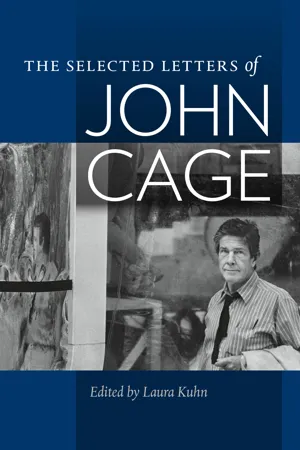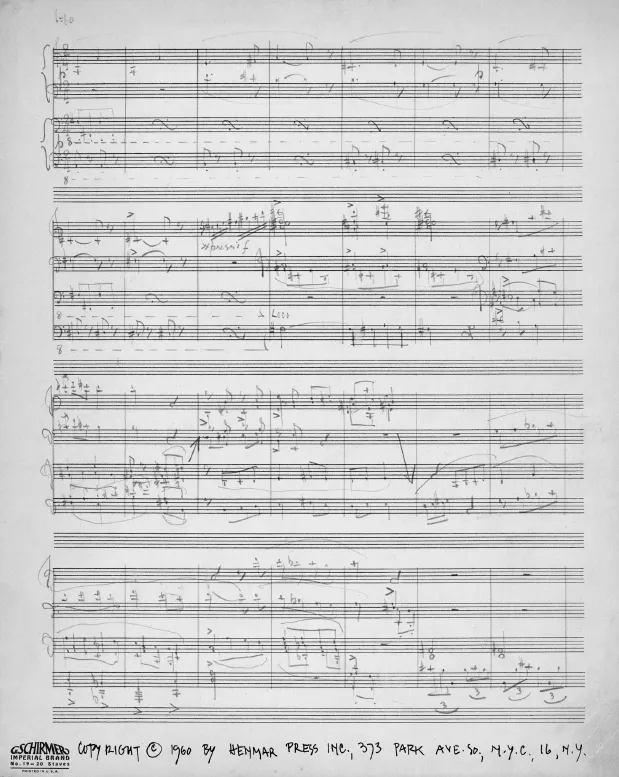![]()
PART ONE
1930–1949
IN THE SUMMER OF 1930, the adventuresome seventeen-year-old John Cage dropped out of his first year at Pomona College in California and began an eighteen-month trip abroad. Much of the time he traveled with Harvard-educated Don Sample, ten years his senior. From Algeria and elsewhere he wrote home with great enthusiasm to his parents: his father, John Milton Cage Sr., a professional inventor, and his mother, Lucretia Harvey Cage, better known as “Crete,” a journalist with the Los Angeles Times. His letters are brimming with excitement and wonder at the people and places he encountered. Paris awakened him to modern music, and while in Spain he did some composing.
Cage’s pursuit of a musical career began in earnest after his return to California late in 1931. Hoping to study with world-renowned Austrian composer Arnold Schoenberg, who had settled in Los Angeles after fleeing Nazi Berlin, Cage began taking composition lessons with the pianist Richard Buhlig, who was much praised for his Bach interpretations and who also played contemporary works. Buhlig advised Cage to find a path to Schoenberg through one of his former students, Henry Cowell, with whom Cage then briefly studied. Cowell suggested that Cage get in touch with Adolph Weiss, the first American musician to have studied with Schoenberg. Weiss, then living in New York, agreed to take Cage on as a student, and in April 1934, Cage, with Don Sample, arrived in Manhattan. Cage took a lesson from Weiss every day and attended Cowell’s weekly class in ethnomusicology at the New School for Social Research.
In early 1935, his education well under way, Cage returned to California and began attending Schoenberg’s classes both at the master’s home and at USC and UCLA, studying musical analysis and probably also composition. For a while he also took horn lessons from a local symphonist, Wendell Hoss, but, engrossed in his work with Schoenberg, soon gave up the instrument. Cage was broke more often than not, but also willing to do whatever work came his way. He took on various odd jobs—dishwasher, recreation director for children in schools and hospitals, and, with much enjoyment, scientific researcher for his father. He also went door to door in his neighborhood, selling subscriptions, mostly to housewives, to a lecture series on modern music and art he created ad hoc.
Cage’s youthful relationship with Sample was sexual, but in the midst of his musical studies, he found himself in love with two women, and at the same time: Pauline Schindler, forty-one years old to his twenty-two and separated from her well-known architect-husband, Rudolph Schindler; and Xenia (Andreyevna) Kashevaroff, a far-from-orthodox daughter of the archpriest of the Eastern Orthodox Russian-Greek Church of Alaska. Schindler’s career as a writer, editor, and lecturer on architecture and the visual arts was advanced. She was considered an agent for modernism, as photographer Edward Weston once described her, “the ideal go-between for the artist and the public.” Kashevaroff, a former art student at Reed College who in time would leave her mark as a sculptor of abstract mobiles, bookbinder, and conservator, was reportedly small and feisty, possessing what Cage called a “barb wit.” Weston, Xenia’s erstwhile lover, described her as “most delightfully unmoral, pagan.” Indeed, Weston’s 1931 photographs of Xenia, some involving full frontal nudity, capture something of her wanton spirit. Cage declared his meeting with Xenia love at first sight, and the two were married in Yuma, Arizona, on June 7, 1935.
Few of Cage’s letters survive between 1936 and 1938. It is known, however, that a new stage in his career began in the fall of 1938, when he joined the faculty at the adventurous Cornish School in Seattle. Within a rich academic environment that trained students in the interdependence of the arts, Cage gave courses in experimental music and modern dance composition, and served as an accompanist for modern dance classes. Having developed an intense interest in percussion music—regarding it as the perfect ground to explore the vast universe of sound—he collected and constructed percussion instruments and organized a percussion ensemble. On Dec. 9, 1938, in Seattle, he produced what may be the first concert devoted entirely to percussion music in America. Soon after, he took his musicians to perform at schools around the Northwest, touring as the Cage Percussion Players, sometimes with Bonnie Bird and her Cornish School dancers.
Cage’s letters resume in 1939, and for three summers he taught in the Dance Department of Mills College in Oakland, California. He also entered into what would be enduring relationships with others in his chosen field. The first summer, 1939, he offered a class in percussion jointly with a fellow student of Henry Cowell’s, Lou Harrison. Brought together by Cowell, Harrison and Cage partnered to compose Double Music (1941), working separately without consultation and then putting their parts together. It was also at Mills College that Cage first met the composer and music critic Virgil Thomson, with whom he entered into an equally long if more troubled relationship.
Cage’s music began to be noticed; his 1940 concert at Mills College, with seventeen percussionists, yielded enthusiastic notices in the San Francisco Chronicle and Time magazine. His reach was also widening, and he gained an important champion in Peter Yates, a music critic and writer for the magazine Arts & Architecture. Yates, with his wife, Frances, held concerts featuring avant-garde compositions on the roof of their Los Angeles home, aptly publicized as Evenings on the Roof. Yates explained and supported Cage’s radically new ideas in many published articles, and the two forged a close, important friendship.
Cage’s various musical pursuits came together in his desire to establish a Center for Experimental Music. He worked hard to gather funds and to persuade a variety of institutions to sponsor it, but his overtures were either turned down or ignored. Among those to whom he proposed the center was the émigré painter/photographer László Moholy-Nagy. Formerly an influential teacher at the Bauhaus in Germany, Moholy-Nagy had established a sort of American Bauhaus in Chicago, the School of Design. Accepting an invitation to teach there, the Cages moved to Chicago in the fall of 1941. In addition to delivering his course Sound Experiments at the School of Design, Cage taught and performed elsewhere in and around Chicago, a city not much to his liking. He and Xenia befriended Rue Shaw, president of the distinguished Arts Club of Chicago, where Cage would give an explosive percussion concert in early 1942 involving tin cans, a siren, and shattered bottles that received national attention.
Late in 1941, Cage was commissioned by Columbia Workshop of WBBM and Columbia Broadcasting System to compose a radio play with sound effects on a text by the poet Kenneth Patchen, also resident in Chicago. Poet and composer together created The City Wears a Slouch Hat, which was given its one and only live broadcast over the CBS network on May 31, 1942, a Sunday afternoon. The public response from across the nation was a lively jumble of boos and hurrahs. Emboldened by the experience, Cage and Xenia moved to New York City in the summer of 1942. They lodged for a few weeks at Peggy Guggenheim’s “Hale House,” then in Montclair, New Jersey, with Cage’s parents, who themselves had moved east. He gave his first New York concert at the Museum of Modern Art in association with the League of Composers that was covered extensively in the press, including a pictorial spread in Life (March 15, 1943). And although Cage’s letter dated January 11, 1945, requesting exemption via a III-A classification from the draft hasn’t survived, we know that he avoided military service on the basis of Xenia’s (slightly exaggerated) poor health, as was reported to the Selective Service System (Local Board No. 219, Los Angeles, California) by one Ernest W. Kulka, M.D.
Gradually, Cage was turning away from composing percussion music to writing exclusively for the piano, both prepared and unprepared. Cage had long-standing interest in experimental instruments, as his many references to such composers and inventors as Luigi Russolo, Léon Theremin, and Edgard Varèse attest. His own prepared piano would bring him national attention. Inspired by Cowell’s earlier unorthodox experiments, Cage had devised his new instrument while at the Cornish School, bringing forth unusual timbres from the piano by inserting various objects (rubber washers, screws, bolts, weather stripping) between its strings. Chief among his compositions for the instrument would be his Sonatas and Interludes (1946–1948); the pianist Maro Ajemian, a devotee of contemporary music, would give the first partial performance of the work on April 16, 1946, at New York’s Town Hall, which was enthusiastically reviewed in the New York Times, the Herald Tribune, and elsewhere. As Cage worked to complete the piece, which was ultimately dedicated to Ajemian, his friend Lou Harrison, who had also moved East, suffered a nervous breakdown. To help defray the cost of Harrison’s treatment in a New York sanatorium, Cage sought and secured assistance from a composer whose music Harrison advocated passionately, Charles Ives.
Cage’s letters from the early 1940s tell us much about the onset of his relationship with Merce Cunningham. The two had met in 1938 at the Cornish School, where Cunningham, then nineteen years old to Cage’s twenty-six, was enrolled as a theater student but taking a class in modern dance which Cage sometimes served as accompanist. The two reconnected while the Cages were in Chicago, but their friendship didn’t blossom until both were resident in New York where Cunningham had earlier moved to join the Martha Graham Dance Company. Cunningham began making dances to music by Cage, and, ever more intrigued by each other’s ideas and work, the two soon became lovers. Cage’s letters reveal a stormy start to the relationship, he being by turns ecstatic and bereft. In either case, his work was clearly enlivened by the close proximity of a genuine and promising colleague. Unable to tolerate her husband’s diversion, Xenia left Cage in 1944; despite attempts to reconcile, they divorced in 1946.
Artistically, Cage’s union with Cunningham was an immediate success. Their first recital together, in April 1944, included six prepared piano pieces by Cage with solo dances by Cunningham. The reviews were glowing. Among other acclaimed early collaborations was their May 1947 performance of The Seasons at Broadway’s Ziegfeld Theater, with scenery and costumes by Isamu Noguchi.
Throughout these years Cage undertook much else. He considered composing a dance score for Edgar Allan Poe’s “The Bells,” an idea proposed in 1945 by the dancer/choreographer Ruth Page and her husband, Thomas Hart ...

